The old copper mine entrances dotting the hills of Michigan’s remote Keweenaw peninsula suggest a geological precariousness. It’s the balancing act of all that ancient basalt. You sense the testing of angles and weight. The pushing of limits. You see the hubris in the dynamited tunnels braced with wooden support beams that seem impossibly feeble. The word “splintered” comes to mind if ever the ceilings were to fail.
At the cold mouth of this particular entrance, gouged into a hill in Greenland, Michigan at the southern cusp of the Keweenaw, there is a robust, grille-like cage cemented into the opening’s circumference, slatted for the bats to go echolocate their dinners, yet stout enough to dissuade the local “copper rats” – the name given to human scavengers searching for mineral scraps to sell for quick cash. The gate is impressive, seemingly impenetrable. But Dave Sarazin, my guide, has the key.
“We’ve had to overbuild the security,” he says as he clicks on his Petzl headlamp and fiddles with the lock.
Not long ago someone dug a pit beneath this gate’s bottom just to drink some Bud Light beers inside. Before that, someone broke into the main shaft and spray-painted THANKS FOR THE SILVER! on the way out.
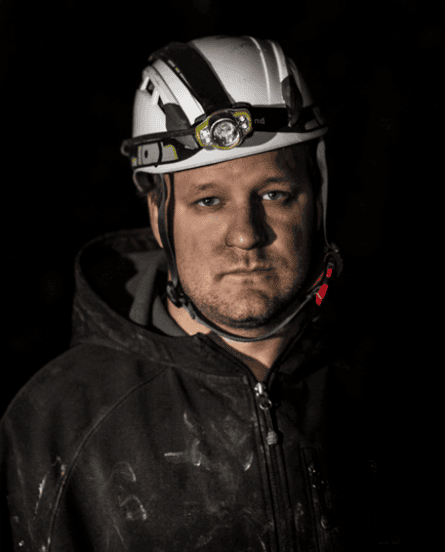
Sarazin is a Keweenaw kid, born and raised. He grew up exploring the old mines that splay like arteries around his town, corridors that once bustled with enough extraction to become the world’s leading producers of copper. Many billions of pounds of the soft metal left these veins to become wire, bullet casings for multiple wars, the hull-covers of big boats and decorative knobs for an earlier epoch’s finest furniture.
Eventually, the expense of burrowing underground for a malleable, difficult-to-extract metal eclipsed the profits. By the early 20th century, mine after mine went bankrupt, with only a few surviving past mid-century. The two counties comprising the uppermost finger of the peninsula are currently home to 60,000 fewer souls than their almost 100,000 population peak in 1910.
If that mass exodus could have only paused, slipped on future-vision goggles and peered a few hundred years ahead to a climate-changed continent, one in which the Upper Peninsula, according to Popular Science, would be the nation’s sweetest real estate by 2100, perhaps more would have dug in their heels. But who knew? And what would they have done in the meantime?
Growing up in the industry’s atrophying wake, all Sarazin and his friends understood was that they inherited a mostly forgotten subterranean playground.
“There was so much risk,” says Sarazin of his early explorations, many of which unfolded on private property. “The risk of getting caught; maybe it’s some landowner, maybe it’s the cops.”
Going underground for profit or fun is just what you did here, part of the geographic and adolescent landscape. Gangs formed around who knew which highly secret, highly coveted access points. If you saw someone from a rival group while scavenging, and you weren’t up for a fight, you gave them a quick nod and moved rapidly on. If they asked you what you found, you always said: nothing.
“They’re after the same stuff as you,” says Sarazin.
These tunnels – and the treasure hunts within them – were lifeblood for generations of post-industry Keweenaw youth, the best and cheapest entertainment around.
They were also the same damp corridors where Sarazin’s great-great-grandfather and great-great-uncle once shoveled out the giant stopes by candlelight before the walls caved in and buried father and son alive.
Sarazin, in fact, was the first generation of his family since 1840 to not be officially employed by the copper mining industry.
That was before he found a legitimized way back underground by picking up a guide gig a few years ago at the Adventure Mine Company, a tourist operation that brings paying customers into the old shafts to experience a sliver of what it was like, although it’s hard to truly convey the grueling, precarious nature of the industry in an hour-and-a-half jaunt lit by LEDs.
Adventure ended its mineral extraction in 1920 only to have all but the top of its levels fill quickly with water, drowning a dozen underground corridors still littered with iron relics and mineral treasures. A young, ambitious new owner, Matt Portfleet, bought the whole operation in 2004, seeking to marry his love of geological exploration and discovery with a viable cottage industry.
After college at nearby Michigan Tech, he, too, wanted to stick around the Keweenaw.
“I was looking for ways to do something I enjoy and to stay up here,” he says. “Adventure Mine became an avenue for that.”
Now, Sarazin, along with Portfleet and a handful of other tunnel-lovers, lead small groups through the subterranean grid and, for those customers willing to pay a little extra for the full “Captain’s Tour”, they get to rappel all the way to the bottom of level two where the dark water below sits as still as glass.
That’s the new grail: pump out the water and hit terra firma at the bottom of level three.
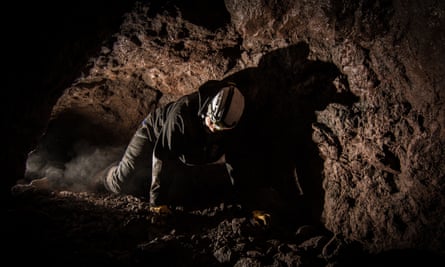
On that clear, sunny day, Sarazin swings open the gate to the mine entrance and I can see my breath in the air before entering. The underground temperature at this level stays at 48 degrees year round, regardless of fluctuations on the surface. The deeper you go, the warmer it gets.
Sarazin wants to show me where he and Portfleet have made some progress on the third-level water with a diesel pump. They’ve been at it for awhile. Humping fuel down two levels by hand slows their progress, but a new solar-powered pump is on its way.
The potential of fuel-free, year-round pumping makes Sarazin almost giddy.
“We’re already seeing stuff that hasn’t been above water since 1917,” he says of the work the temporary diesel pump is doing. “And the beauty is that we don’t have to worry about the copper rats grabbing up everything like we did when I was a kid.”
That’s what the gates are for.
Sarazin is one of the few of his original gang who stuck around the Keweenaw, not for lack of mobility (his friends have moved away to become doctors, lawyers and, in one case, an explosives expert in Minnesota), but because of his love of these old mines, the entrances of some known only to old locals sipping bourbon at the bar.
And so Sarazin became part collector, part conservationist, part immersion historian. The hunt has never ceased to excite him, and although a significant find – perhaps a sizable chunk of silver, like one pulled from Adventure a few years ago – could fetch thousands, Sarazin insists it’s not about the riches.
“I’m not in it for the money,” he says. “It’s something about the fact that no one has ever seen it before. It hasn’t been exposed to the world, ever. The rarity of it.”
If Sarazin and Portfleet can get the third level dewatered, they have hopes of expanding their tours. After they scour for treasures, of course.
Parts of these corridors are the result of a two-hundred-year-old Cornish mining technique involving two to three men, one with large iron chisels of increasing lengths, and the others with eight-pound sledgehammers. The chisel man would hold, the hammerers hammer, until they had achieved a deep enough “shot hole” in the rock to implant the explosives – originally black powder, eventually stabilized nitroglycerine developed by Alfred Nobel in Sweden.
A standard shift, according to Larry Lankton in his book, Hallowed Ground, was 10 hours a day in a “dark, rough, hazardous, enclosing, steeply pitched” world, where the “sounds of hammer blows and the smell of spent blasting powder” suggested a singular mission: “to liberate copper and bring it to the surface”.
As the industry accelerated ahead of burgeoning safety regulations, many miners, like Sarazin’s ancestors, never surfaced themselves.
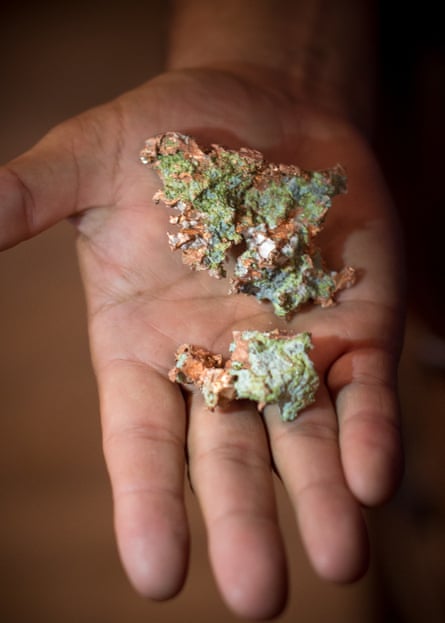
With more than 5,500 visitors a year, Adventure is holding its own, although no one’s getting rich.
When it comes to metallurgical riches, though, the Keweenaw is indeed a pretty spectacular swath of land. The purity and quantity of native Michigan copper is unmatched anywhere else on the globe.Copper pride in the Keweenaw runs deep.
Below the Adventure Mine bluffs, two levels down and squatting around an access hole to level three, Sarazin and I turn off the pump in order to study the water. I see bubbles rise and pop at the surface.
I don’t tell Dave, but I feel panicked. I’m breathing heavy. I think about gas explosions and cave-ins.
Sarazin tells me that in 1950, at nearby Caledonia mine, a quiver of old, rotting timbers off-gassed enough to fill the underground atmosphere with a haze of methane that ignited with a miner’s lit cigarette, killing three in the blast. They, too, were dewatering a drowned level.
I imagine fire on my face. The weight of a mountain on my chest.
“That was a long time ago, though,” he says. At a different place. He tells me not to worry. He says everything will be fine.
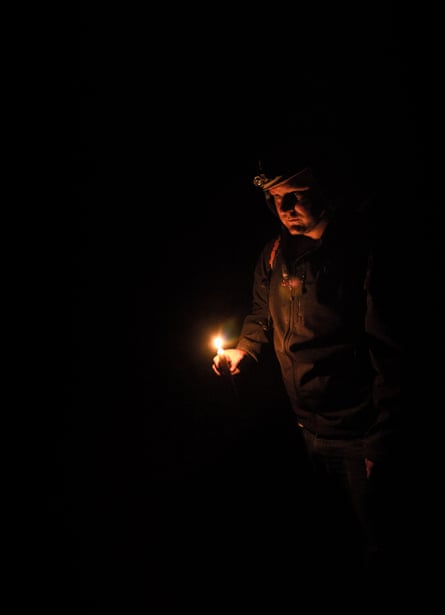
The Keweenaw is at a crossroads. An industry of extraction has mostly ended, entire towns have emptied, and those who cling to this place are looking for what’s next. With the right eyes, there’s plenty to see.
In Houghton – a town Outside Magazine recently named number 14 of the coolest 16 cities in which to live and adventure in the United States – a population of almost 8,000 doubles with the Michigan Tech school year. After graduation, many, like Portfleet, don’t want to leave.
You can buy a turnkey home for under a $100k in the center of town, play outdoors year-round, and generally live a life that in, say, Boulder, would cost 10 times more.
These are price points and amenities that tend to attract artists, entrepreneurs, new generations of explorers. Imagine Asheville or Missoula 30 years ago.
The nearby Porcupine mountains claim the most annual powder east of the Rockies.
Along that same range, according to Houghton’s Daily Mining Gazette, a small renaissance of copper extraction could soon employ 320 souls for up to 15 years, almost 200 of which will again spend their dark days underground.
In their sweeping prognosis, Popular Science was just aggregating information from sources like the the EPA who tell us that in the hot years to come, climate change will probably increase fresh water demand while shrinking supplies. Along with stable weather conditions, this could perhaps become the Keweenaw’s new copper: there is no more pure and vast a reservoir than the three-quadrillion-gallon lake hugging the peninsula.
Part of Sarazin’s diaspora, friends with graduate degrees who landed gainful employment in far-off places, fly back to the Keweenaw now just to attend job fairs, stacks of résumés in hand, eager to return. Perhaps the thirsty northward migration has already begun.
Meanwhile, the Adventure crew is finding ways to expand their profile, hosting an annual mountain bike race that dunks riders momentarily into the mines before resurfacing, inviting a film crew into the shafts to shoot a movie about dwarves trapped in a mine collapse alongside a monster.
Sarazin played a small role as the location manager, guiding the crew using mine maps that date back to the turn of the 20th century.
“They’re actually pretty accurate,” he says of the old cartography.
And Portfleet offers custom gate construction for landowners who want to close up their old mine entrances to keep out the copper rats and let in the bats. He claims a certain expertise, having conquered so many gates himself as a young adventurer.
“We did some pretty stupid things,” he says in an act of transparency on his website. “But I learned tricks to defeat gates and now use that experience to design gates to keep people like myself out.”
This is what sticking around looks like.
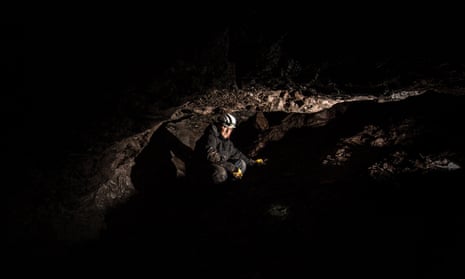
Comments (…)
Sign in or create your Guardian account to join the discussion